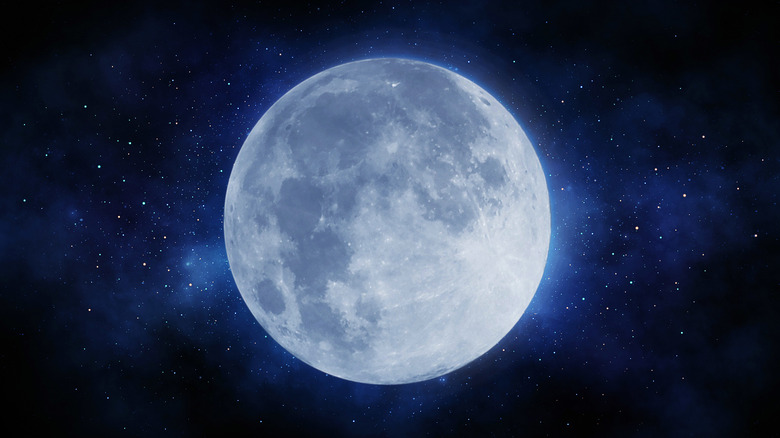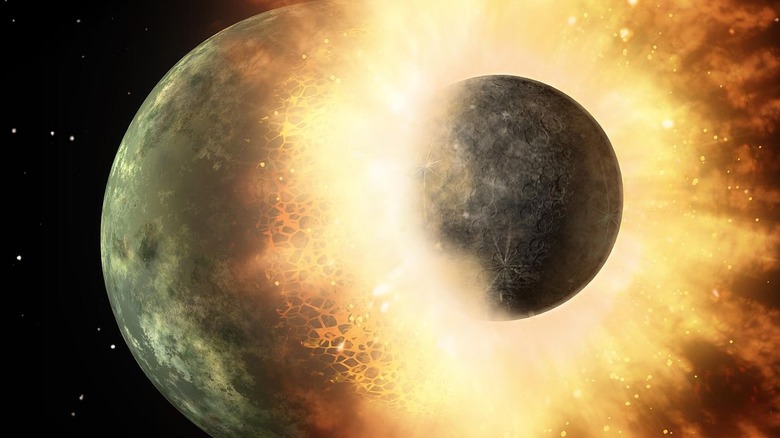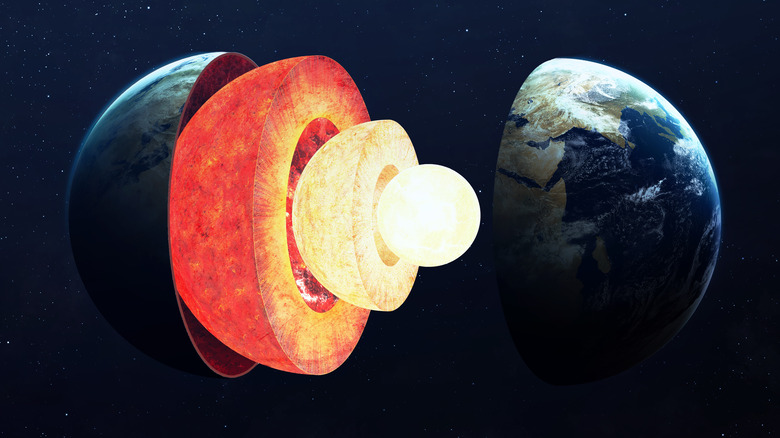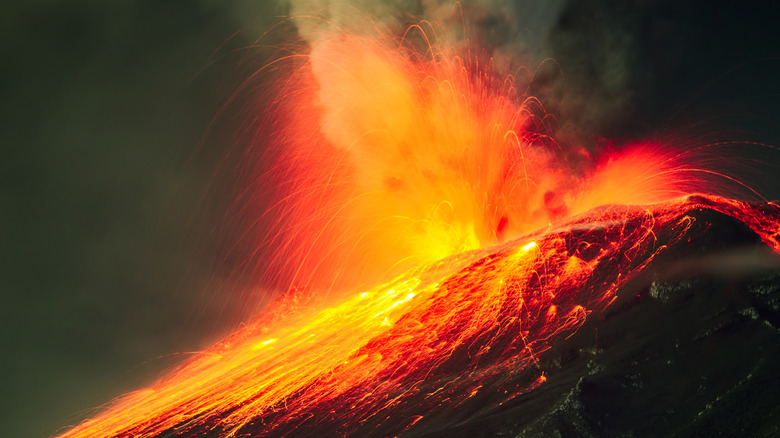The Truth About Theia, The Planet That May Be Stuck Inside Earth
Moons, in a general cosmological sense, aren't too uncommon. But Earth's moon — "the Moon" — is actually quite special. It's unusually large in comparison to Earth, at 27% Earth's size, which accounts for tidal forces that may, as Scientific American outlines, actually be the reason why life developed here on Earth at all. It also happens to be, eerily so, just the right size to completely block the sun during a solar eclipse — the Moon is 400 times smaller than the Sun, which is 400 times farther from Earth than the Moon (again, per Scientific American). It's also "tidally locked," meaning its rotational and revolution rates are synchronized so that one face of the Moon — you know, the "dark side" — always faces away from us (again, Scientific American).
Heck, it's even the friend that will never leave us, as Space Answers explains. The Moon moves 3.8 cm away from Earth every year (it used to be a lot closer), but also slows down the Earth's rotation by 2 mm per year. Eventually, a future-Earth day will become a present-Earth month, the tides will lock, and both the Earth and the Moon will die side by side, consumed in the flames of the Sun's red giant phase, so — never mind. Back on track.
But how did the Moon even get there? As it turns out, we have another bizarre, cosmic coincidence to thank: Theia, the rogue impactor protoplanet.
A rogue protoplanet likely collided with early Earth
Understanding Theia begins with understanding what's called the "Giant Impact Hypothesis," which developed in the 1960s and '70s as a way to explain how the Moon became our stalwart, glowing, nighttime companion. Besides the Giant Impact Hypothesis (per Space), we've got the "Co-formation Theory," which simply says that Earth and the Moon developed in tandem from the cohering of particle groups, and the "Capture Theory," which says that Earth's gravity snagged a passing, rocky body kind of like Mars did with its moons Phobos and Deimos. But there are problems with both of these theories, and besides, they're not as cool as the Moon being formed by a cosmic car accident.
And yes, that's what the Giant Impact Hypothesis states: the Moon formed as the result of an impact between Earth and some other spacefaring body. They hit, a big fragment jettisoned from the impact like shrapnel, was snagged in the orbit of the newly fused combo of Earth-slash-Theia, became spherical because of gravity, and voilà: we've got endless and poetic analogies for moonlit romantic love and shroud-of-night liaisons.
We've always known, at least, that the Moon used to be hot. The dark patches on its surface (called "maria," Latin for "seas") were once lava pools in a surface-wide magma ocean from 4.2 to 1.2 billion years ago, as NASA explains. This jives with the Giant Impact Hypothesis, which estimates that the protoplanet impact would have happened about 4.5 billion years ago.
Theia exists in the mantle of Earth
Fast forward to 2021, and we've got the first real evidence for the existence of Theia, the protoplanet that struck our nascent Earth. At the 52nd Lunar and Planetary Science Conference in March, 2021, Qian Yuan, geodynamics researcher at Arizona State University (ASU), Tempe, presented data — not fully verifiable proof — supporting the Giant Impact Hypothesis. The thinking that lead to his research is ingeniously simple: If Theia hit Earth, it didn't vanish; it would have merged with our planet, and there must be evidence for its existence here. Or as Yuan said, per Inverse, "This inspired me to think the missing Theia may go into the Earth after the impact."
"Into the Earth," in this case, doesn't mean that a whole planet is kind of hanging around inside Earth like an avocado pit or a nested Russian Matryoshka doll. Yuan and his team focused on two continent-sized regions of Earth's mantle (the bit beneath the crust and the molten core): one beneath West Africa, the other beneath the Pacific Ocean. These regions have baffled researchers for decades, because seismic waves from earthquakes inexplicably slow down when passing through — by 1 or 2% — leading to their moniker "low-shear velocity provinces," or LLSVPs, as Observer explains.
These areas are not only part of Earth's mantle, they're the biggest part, at 8%. They're also 80-90% the size of Mars, which when combined with the Moon, equals almost exactly the theoretical size of Theia.
Analyzing Apollo moon rocks and Icelandic volcanic basalts
Other, more hardcore scientific evidence for the impact of Theia and Earth comes from analysis of the Apollo Moon rocks. (You know, the rocks that don't exist from the fake Moon landing that didn't happen, and yes, we're rolling our eyes).
Basically, as Science Magazine says, Yuan's co-author Steven Desch, astrophysicist at ASU, measured the ratios in Moon rocks of hydrogen to its heavier cousin, the isotope deuterium. Such rocks, if they resulted from a protoplanet collision, would have come from a rogue impactor with an "iron-depleted core and an iron-rich mantle," the latter of which would have to have a mantle 2-3.5% denser than Earth's. And lo and behold, this is almost exactly the density of the LLSVPs under West Africa and the Pacific Ocean: 1.5-3.5%. They didn't totally mix with Earth's mantle on impact, but stayed glommed together and sunk to the lower part of our mantle, at its boundary with our planet's core.
Yuan and Desch's findings also line up with geological evidence accumulated over the past decade, as Discover explains. Lava from volcanos on Iceland indicate that the Earth's mantle is "heterogenous," meaning that it contains two separate sources of isotopes: Earth's, and it would seem, Theia's. These samples come from the precise time when an impact would have happened, within the first years of Earth's existence — about 4.5 billion years ago.



